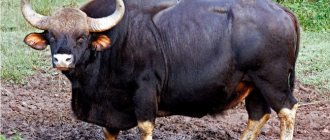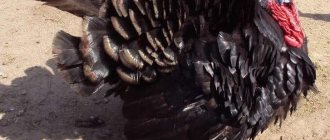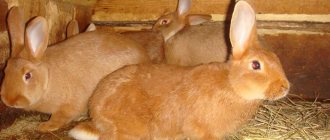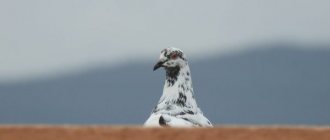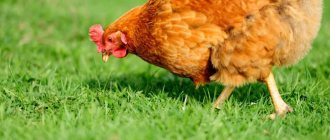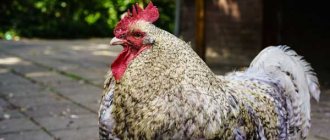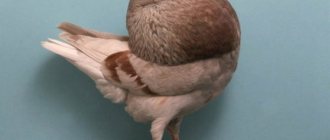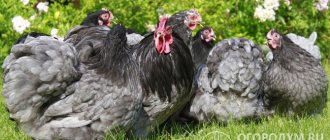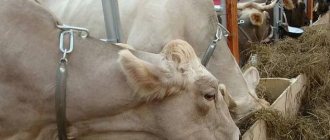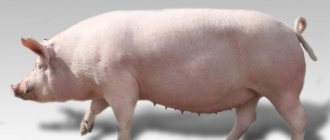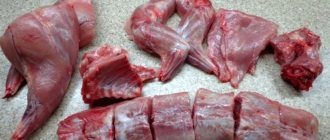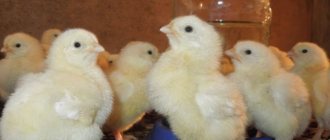Poultry farming » Pigeons
0
1495
Article rating
Kira Stoletova
Until recently, Kingi pigeons, used only in cooking, today decorate bird shows and fairs. This breed was bred from the parent Vikings and Postal, and to this day it has not lost its popularity among poultry farmers.
Description of King pigeons
Much has been written and debated about the benefits of pigeon meat and the peculiarities of raising the King breed. This species of birds has caused a stir among farmers and owners of large farms.
Origin
The King breed itself was developed in the USA at the turn of the 19th and 20th centuries. The first breeders sought to create a breed that would have the following properties:
- It was capable of carrying letters, like carrier pigeons.
- It was meaty enough and quickly gaining weight to satisfy the needs of pigeon lovers.
As a result, the first kings were noted in breeding books in the 1890s. In 1921, breeders created the first standard for this pigeon breed in order to agree on future selection paths.
Subtleties of reproduction
Kings are a prolific breed. Birds become suitable for breeding at 6-8 months; they have 5-6 broods per year. Oviposition occurs 1.5-2 weeks after mating, the doves lay 1-2 eggs. The offspring are incubated for 16-19 days.
A week after the start of hatching, the eggs need to be checked in the light for the development of the embryo, since it happens that not all eggs are fertilized. In fertilized specimens you can see a dark spot - this is the embryo. The changed color of the shell also indicates the successful development of the chick. After a week of incubation, it becomes dull gray.
Kings fly poorly, so nests need to be placed on the ground or low above the floor. You need to attach a ladder to the shelves, along which the females will climb up. Nests should be placed not side by side, but at intervals, because females do not like close proximity to each other.
While incubation lasts, you should not disturb the females, remove them from the nest, touch or turn over the eggs. Due to interference, the bird may abandon the nest and the embryos will die. After hatching, the pigeons remain for a month with the females, who feed them first with secretions secreted in the crop, then feed them with grains and gradually transfer them to adult food. Male kings are sometimes mated with females belonging to sporting breeds. The result is offspring with excellent meat characteristics.
See also
History of the appearance of fighting pigeons, descriptions of the top 6 breeds and contentRead
General impression
Large pigeons, stately, densely built. The plumage fits well to the body. The feathers are smooth and do not bristle.
Appearance – somewhat overfed and too fat pigeons. Kings really lack elegance, but they compensate for this with their seriousness and charisma: this is not a dove, but a dove that you want to address by name and patronymic.
StandardFeaturesMeat productivity
According to the standard, a king pigeon must meet the following requirements:
- The head is large and smooth. The eyes are small, in individuals with dark plumage - amber, in white pigeons and doves - dark. There are usually thin red-purple lines around the eyes.
- The beak is powerful, well developed, there are no requirements for color or degree of development. The wax is tender, as if slightly powdered.
- The neck is of medium length, moderately developed. The wings are short and densely feathered. The tail is short, poorly developed.
- The back shape is wide.
- The legs are of medium length, there is no feather cover.
In general, the king pigeon's body structure is more similar to a broiler chicken than to a pigeon. The reason for this is the purpose: this is a meat weakly flying breed.
The character of the kings is lively, combative, and sometimes aggressive.
Vitality is high. The breed is not demanding regarding breeding conditions, so there are practically no problems with breeding.
Brood quality is high. Doves of this breed are excellent mothers, they hatch eggs well, and their egg production is plentiful . The only exception is exhibition specimens: their fertility is reduced.
The king pigeon breed has the following advantages:
- high egg production in pigeons under 3 years of age;
- fast growth. By 6-8 months, king pigeons are ready to mate;
- rapid weight gain;
- preservation of the meat qualities of the breed when crossed with other pigeons.
The disadvantages are as follows:
- doves often incubate unfertilized eggs;
- tendency to obesity. Because of this, when industrially breeding pigeons for meat, king pigeons are often crossed with carrier pigeons - large birds are obtained with a large amount of meat rather than fat.
King pigeons are a meat breed. Their meat has a delicate taste, moderate fat content, high volume (especially when crossing male kings with doves of sporting breeds), and moderate fibrousness.
King pigeons are usually slaughtered for meat at the age of 4 months, when the young animals gain weight more than 600 g and combine good mass and tenderness of meat . You can wait and slaughter males weighing more than a kilogram - but their meat is tougher and more fibrous than that of young animals.
Kings, like other meat breeds, allow the slaughter of young animals at the age of 28-35 days. However, the specific time of slaughter depends on the growth of the particular bird, feeding conditions and other features of keeping the pigeon population. Here the poultry farmer faces two problems at the same time:
- do not overcook the meat, making the meat too fatty and tough;
- do not kill too early, without allowing the young pigeons to grow to optimal condition and gain the required weight.
How to properly keep and care for birds
Pigeons of the breed are not too demanding on conditions and can be raised in a spacious poultry house. But it is advisable, for better health and weight gain, to provide a covered walking area next to the poultry house. Inside the dovecote you need to install a ventilation system, heating, and lighting if necessary. Kings, due to their heavy weight, are reluctant to fly, but behave calmly when walking.
See also
Description of the top 5 beautiful breeds of white pigeons, their advantages and disadvantagesRead
Pigeons are fed grain and legume mixtures, into which you can put any grain; large ones, such as peas and corn, need to be chopped. Fresh herbs, some grated vegetables, and feed additives are added to the grain. Minerals and vitamins have a beneficial effect on the development of the bird's body, the maturation of young animals and future fertility, and prevent and protect against diseases.
An adult bird can eat 50-65 g of grain per day. This amount should be divided equally and given to pigeons 2 times a day. You cannot feed spoiled, sour, and especially moldy food. Water in drinking bowls should be poured around the clock. It needs to be changed every day. In winter, heat it up if the room is cold.
Expert opinion
Zarechny Maxim Valerievich
Agronomist with 12 years of experience. Our best country expert.
Ask a Question
Kings are considered aggressive, so it is not advisable to keep them together with pigeons of other breeds. They suppress them with their mass. As a last resort, you can add small breed chickens to the pigeons
.
Content
Pigeons are kept in enclosures, with nests built on the floor or a small elevation, where the birds can reach using perches. We must remember that although this breed is considered to fly, it flies very poorly and prefers to nest on the floor, like chickens or quails. There are no special requirements for keeping kings: the usual conditions for breeding meat birds are suitable for them. These pigeons are undemanding and grow easily in any conditions.
However, if they are bred en masse for meat, care should be taken to ensure that the birds do not fly away: kings still fly. Therefore, it is better to use either enclosures indoors or large cages. Living in dovecotes is bad and inconvenient for kings, even if they are raised as exhibition specimens and not as meat.
Breeding pigeons for meat as a business. Nuances of the organization and real income figures
Article
Breeding pigeons at home for beginners. How to gain experience
More details
Birds of prey that pigeons are afraid of. Reminder for pigeon breeder
Article
Basic information that a poultry farmer needs to know about the physiology of pigeons
Read
Rules for keeping pigeons: what should be in the dovecote and how to organize the feeding regime
More details
Artificial incubation of pigeon eggs: what are the features of the process and what to do after the chicks hatch
Read
Main pros and cons
Advantages and disadvantages
large size birds;
the ability to grow for meat;
variety of colors;
decorativeness.
When kept only in a poultry house, without walking, kings show less productivity.
Diseases
Kings do not have any specific diseases characteristic of this breed. Therefore, safety measures during breeding are standard for all poultry farming: treatment of the aviary, cleaning of nests, sterilization of litter, proper feeding.
Most often found among kings:
- Paratyphoid. Symptoms: droppings of a liquid consistency with blood and mucus, contamination and sticking of tail feathers, a large number of unfertilized eggs, death of embryos, joint damage.
- Coccidiosis. Symptoms: lethargy, weight loss, head pulled into the body, paralysis of the limbs, liquid droppings with mucus and blood.
- Worms. Symptoms: general poor health, dull plumage, weight loss, poor appetite, anemia, and sometimes paralysis.
- Parasites
- Infectious
Trichomoniasis
Main symptoms, measures for treatment and prevention of the disease
Read
Worms
What is the danger of infection, how to treat and prevent it
Read
Paratyphoid
A disease that leads to pathological changes in the gastrointestinal tract and the development of septicemia.
Read
Psittacosis
Disease with severe respiratory disorders
Read
Coccidiosis
An infectious disease that affects the tissues of the gastrointestinal tract
Read
Smallpox
Infectious disease of pigeons. Affects the skin, mucous membranes and leads to the death of the bird
Read
Salmonellosis
Characterized by indigestion, fatal to birds
Read
Productive qualities
To obtain an average weight of up to 800 grams, the birds are fattened for 45 days; for exhibition specimens the weight reaches one and a half kilograms. From one female king in 356 days you can get from 13 to 17 pigeons, which are distinguished by their fatness and meatiness. The yield of slaughter weight is on average 59-67%, depending on the growing conditions. Birds are kept in aviary or limited range methods.
King pigeon
Poultry farmers who decide to breed King pigeons using the cage method should know that in a month the pigeon will gain less weight than its brothers. A carcass without giblets weighs about 368 g, and the slaughter yield is no more than 55%. No matter how the Kings were kept, all representatives of this breed will have a meat yield of 50%, fat 16%, edible organs 5%. Everything else is not used as food and must be thrown away.
Photo gallery
External features
This breed was bred at the beginning of the last century by breeders from the USA based on three breeds: Romans, Maltese and Postal. It is bred not only for meat, but also as an ornamental bird.
Its distinctive features are:
- color - white is dominant, silver, red and black are less common;
- the head is relatively large, the beak is strong, of medium size, the eyes are yellow or black;
- neck - short, thick;
- the body is massive, short and wide;
- chest - very wide, convex, rounded;
- tail - short, raised up;
- lower limbs are of medium length, strong, without feathers;
- the wings are short, noticeably widening in front, the bird flies with difficulty;
- behavior is active, males can show aggression towards each other.
Wood Pigeon
This wild pigeon is larger than its relatives. Its weight exceeds 90 grams, body length is 40 cm.
In the habitats of the wood pigeon, you can hear its inviting cooing in the morning.
When taking off, the wings emit a characteristic whistle - this is not typical of all breeds.
The color is gray-blue, with a reddish tint on the chest. There are white spots in the neck area.
Each wing has a white marking, visible only during flight.
It is wary of people, hiding from them in dense thickets.
It is especially hidden during the breeding season. The habitat extends from the African continent to Russian latitudes.
It is a migratory bird and forages for food in the fields.
Many hunters choose the wood pigeon as prey, which affects the number of birds of this breed.
Decorative breeds of pigeons
They are divorced solely for the sake of beautiful appearance. Birds may differ in posture - for example, stately breeds have a strongly protruding chest, unusual color, and shape of plumage. Sometimes various decorative pigeons are very reminiscent of winged relatives of other species - owl, seagull, swallow - and receive corresponding nicknames.
peacock pigeon
The most famous representative of the decorative trend. The name is given by the main external feature - a fluffy tail, the feathers of which are spread out to the sides.
The first mention of these beauties dates back to the 16th century; distant India became their homeland. Since then, the breed standard has changed somewhat.
Today, great importance is attached not only to the tail, but also to the characteristic posture. The description of the standard is very lengthy and contains many details. But the main characteristic of the breed remains the shape of the body - it can fit into a ball when viewed from the side.
The chest is strongly raised up, arched, and the line of the back is concave inward. The tail should not have any distance between the feathers and should be positioned vertically in relation to the body. The standard even takes into account the number of feathers - their number ranges from 32 to 50.
Pouters
It's every fan's dream to launch a flock into the sky. All because of the bright appearance, which arose due to the enlarged goiter area.
The homeland of these gentle creatures is Europe. The most popular varieties are from England and the Czech Republic.
Pouters should be kept separately from other pigeons in order to maintain the purity of the breed and selection should be carried out.
The bird requires careful care, unlike its outbred counterparts. Each breed has its own standards. But there are also common features:
- Vertical position of the body.
- The body is large, the head is small with a round forehead.
- Puffers are capable of strongly inflating the chest, which protrudes majestically forward.
- Long wings, feathered legs.
With such a spectacular appearance, the blowers fly rather poorly.
Texan pigeons
These are precisely the animals that were able to incorporate first-class meat qualities and a decorative exterior, forcing pigeon breeders to breed these birds. They have completely white, light brown or brown and white colors that are not found in any other breed.
The birds have perfectly adapted to living next to people, and therefore feel great both in the wild and in an aviary. They don't particularly like to fly, but a sedentary lifestyle will cause Texans to become overgrown with fat, which should not be allowed.
The birds have a broad chest and a medium-sized neck. The legs are pink, sometimes red, underdeveloped. Texans have average flight performance and low endurance, but all these disadvantages are covered by the weight of the bird.
These pigeons are second in weight only to the Roman giants.
Are you here
Why are pigeons and meat ones at that? Step No. 1 I always wanted to keep some kind of livestock at the dacha, fortunately there are more than enough premises on a rural estate. But there is one very serious problem: I don’t go there every day. I went through a bunch of materials about animals and birds, and decided to deal with birds, since animals require human presence every day (except for rabbits). But rabbits are uncomfortable with the danger of a sudden epidemic. As we studied the material on poultry, everything turned out to be not as rosy as it seemed at first: Some need walks, others need expensive automation, others need heating, etc. and so on. Incubators, brooders, it turns out that you need to give up everything and deal only with birds, or not deal with them at all and not torment yourself or your pets. On one of the forums I read a conversation about meat pigeons, and the idea of pigeons stuck firmly in my head. If you do poultry in your free time, then do it with meat pigeons. There are a huge number of advantages compared to the disadvantages. 1. There are practically no competitors in the market. As we collected information about the breeds of meat pigeons, basically all the information boiled down to one phrase - “where to get meat pigeons.” 2. Higher price per bird compared to the cost of rearing. For example, a hunting pheasant costs about $15, a pair costs $30; the simplest industrial lines of king - $50 (pair), Polish lynx - $30 (pair). And if you count the costs of raising pigeons and pheasants, the difference is huge. 3. The bird is very resistant to diseases (if properly kept). 4. Does not require heating. 5. Does not require daily presence. 6. Automatic feeders and automatic waterers are cheap. 7. Reproduces in the presence of light all year round, except for molting. Any cheap mechanical daily timer can turn on the backlight in winter. 8. Pigeons are excellent at hatching their chicks. No incubators needed. 9. They are also excellent at raising their young without human intervention. Heated brooders are just an extra detail. 10. They don't need animal proteins like chickens. 11. Exceptional taste and dietary properties of meat. Frankly speaking, there are not many disadvantages: 1. These are monogamous, for each female a male is required. 2. A small number of offspring per year, on average 12-18 chicks. 3. Not a large carcass weight. 4. Not everyone can accept pigeon meat as food. Well, the cons are actually quite controversial. The first fact is obvious, nothing can be done. You may not agree with the second, because a hen will raise barely more chickens per season. Well, regarding the weight of the carcass, there are also smaller birds, the same quail. The fourth is more difficult, due to historically established prejudices. But there are a huge number of lovers who want to buy not meat, but live poultry. After all, selling birds is much more profitable than selling meat. Well, if there are unclaimed chicks left, there will be a connoisseur. And you can grill it yourself and surprise your friends. Step #2. Soon after the decision to have pigeons, the opportunity arose to purchase four King chicks of the industrial line (the parents were transported from Hungary). Within a few days the Kings were in my barn. Because I haven't decided on the content system yet. They were simply released onto the floor of the room. I installed a vacuum drinker and the same feeder, fine gravel, and chalk. That's all the preparations. A couple of photos of my first pigeons:
What do King pigeons look like?
Currently, Kings have found their use not only as meat birds, but also as an exhibition breed. What does the King pigeon look like: photo.
Breed representatives boast a massive size of 700-800 grams. Birds taking part in exhibitions gain weight up to 1.5 kg. Kings have thin skeletal bones, and pigeons with white feathers are predominantly found. Wings with a small span.
Let's take a closer look at the appearance characteristics:
- the thoracic region is rounded and well developed;
- the eyes are small, in pigeons with dark colored feathers they are amber, in white pigeons they are dark;
- have a powerful beak;
- the wings are small and rather short;
- the limbs are distinguished by a strong structure, there is no feather cover;
- tail feathers are short;
- the dorsal region is wide.
As mentioned earlier, birds are very poorly adapted for flight, and they also have an aggressive nature. There are kings with silver and brown feather colors.
Breeds of domestic pigeons
Nowadays, bird lovers are increasingly interested in meat types of pigeons, since they can be bred for a hobby and even for additional income.
The main meat breeds of pigeons with photos and characteristic features will be described below.
Peculiarities
When breeding poultry for slaughter, it is sent for meat as early as possible, because everyone knows that young animals have very tender, juicy and pleasant-tasting meat. Therefore, broilers are raised at home, which quickly gain weight.
Keeping and caring for representatives of meat breeds is aimed at fattening the bird faster, since slaughter is most often carried out 4 weeks after the chick hatches. At this age, carcasses are easier to clean from feathers, and their meat is very juicy and soft.
Description
Today there are a large number of meat breeds. They are divided into three groups: meat, chicken and gigantic. Each group includes several species of birds and is distinguished by certain characteristics.
Outwardly, they resemble ordinary domestic birds, but are larger in size. Representatives of this species are (Figure 1):
- The Moravian Strasser comes from Moravia. These birds have smooth plumage, a wide back, and average height. The main color of the plumage is snow-white, and the head, wings, tail and back are colored. Strassers quickly gain weight, breed well and have a good taste of meat, which is considered a delicacy. They also fly very well.
- The Coburg lark is distinguished by its large weight and wingspan, thanks to which it flies well. These birds are excellent parents, in addition, they give high productivity and are considered the most beautiful among meat birds.
- Prachensky Kanik is a very prolific meat breed. They have a short body, a beautiful figure and head. The chest and back are wide, the neck is medium, the wings are strong. Their meat is considered elite.
Figure 1. Representatives of meat breeds: 1 – Moravian Strasser, 2 – Coburg Lark, 3 – Prahno Kanik
Chicken breeds resemble chickens in appearance, with a small, wide body, small tail, and high legs. They differ from others in their high fertility and heavy weight.
Representatives of chicken species are (Figure 2):
- Hungarian giant: they are characterized by a large body, large head, wide back and chest, and short legs. They differ from others by the abundant feathering of their legs. Feather color may vary.
- Florentine was developed in Italy. It has a long neck, a wide round body, a small tail and long legs. The color can be blue, black, red, yellow, silver. It doesn't fly well.
- Maltese pigeons are native to Germany. Externally they are distinguished by a small body, a long thin neck, long legs and tall stature. Feather color may vary. Such birds have high fertility, but fly poorly.
Figure 2. Birds of chicken breeds: 1 – Hungarian giant, 2 – Florentine, 3 – Maltese
The gigantic species is a giant pigeon with a large build and massive size; it does not fly very well.
Prominent representatives of gigantic species are (Figure 3):
- King was bred in the USA. They differ from other species by their massive body, short raised tail and long legs. The colors come in black, yellow, red and white. Representatives of this species can sometimes reach a weight of more than one kilogram. Very prolific.
- The Strasser is the most popular breed in terms of cooking. They are characterized by heavy weight, high fertility and good taste. The color of the plumage is blue, gray, black, red, yellow. The disadvantage of birds is that they are shy and pugnacious.
- Carnot was developed in France. These birds grow quickly, but their mass is small. They are distinguished by a long pink beak and beautiful black, beige, brown, white and blue colors.
Figure 3. Gigantic breeds: 1 – king, 2 – Strasser, 3 – Carnot
You will find an overview of the king pigeon breed in the video.
Fighting pigeons
They got their name from the unique clapping noises they make during flight. Fighting pigeons have rather narrow wings; the pigeon must make more effort to fly. Narrow wings reduce air resistance; during flight they touch each other with a loud and dull bang. The main feature of pigeons is not the clap in the air; these celestial creatures tumble while flying.
The reason for the somersaults was the powerful and well-developed tail feathers. After a short flight, due to weak wings and a powerful tail, the birds begin to descend strongly; in order to level out the “roll”, the pigeons need to do a somersault so as not to crash on the ground.
Interesting fact! Aerial somersaults cause severe disorientation in the air. And if the bird does not complete a full rotation around “its axis,” it will simply crash to the ground at full speed. Therefore, many pigeon breeders reject slaughter animals that are not able to turn over 360 degrees in the air. Birds' tail feathers are often trimmed to reduce the risk of injury or death.
The group of fighting pigeons includes several breeds that have their own interior and feather color.
What to feed
For feeding king pigeons, cereals and legumes are mainly used, most often in the form of mixtures. This could be wheat, peas, corn, barley, oats, etc. Here is a well-proven feed mixture:
- millet - 30%;
- wheat - 20%;
- barley - 20%;
- peas - 15%;
- corn - 15%.
During the period of active growth of young animals, it is recommended to add a little fish oil, salt, as well as chalk or shell rock to this mixture.
For birds of any age, it is advisable to add succulent green food at the rate of 10 g per day per pigeon; in winter, the greens are replaced with hay or grass meal. In addition, boiled potatoes can be mixed into the food. When feeding, vitamin supplements are usually used (“Chiktonik”, “Trivit”, etc.): during the breeding period, for the prevention of vitamin deficiency, during the growth of young animals. They are used according to the instructions.
The benefits of pigeon meat
The meat of such a bird is highly valued due to its high protein content and minimal amount of fat. In some cases, it is considered healthier than chicken. A bit like game meat. Often used in dietary nutrition. Pigeon meat is valued in many countries.
The main consumers are people who are susceptible and suffer from the following diseases:
- Hypertension.
- Atherosclerosis.
- Cardiovascular diseases.
- Hypertension.
- Problems with the gastrointestinal tract.
Use is recommended in case of general weakening of the body.
It is highly recommended to include pigeon meat in the diet of older people and children.
Raising king pigeons is profitable according to several criteria: tasty and healthy meat, the sale of which generates income, as well as magnificent exhibition specimens that delight with their beauty.
About the breed
The very first mention of King pigeons appeared in 1890. The USA (California) is considered their homeland. The development of this breed is the result of long experiments and natural breeding of different types of pigeons. As a result, after crossing several breeds: postal, Maltese and Roman, breeders received a new species, which was named King.
These birds are a fleshy, thin-skinned breed that has long been widely recognized far beyond the borders of the United States, incl. in Ukraine and Russia.
Even to a lay observer, the photo of the chicken and King will seem similar. Which is not surprising, since the Kings are a chicken-like group of pigeons. They gain an impressive mass for these birds - about 1000 g.
However, the purpose of their breeding is not only for industrial interest; Kings are also kept for demonstration at exhibitions. They are usually more presentable and beautiful.
The most popular breeds
In our country, breeds of meat pigeons are not as widespread as abroad. In total there are about 60 species of birds. Conventionally, they are divided into three groups:
- Chicken;
- Gigantic;
- Meat.
Breeding meat species is becoming more widespread every year.
King
The King breed of meat pigeons was first bred in 1890 in America. This was done after quite a long selection process. The distinctive feature of this meat breed from others lies in the structural features of the individual’s body.
Males have long and widely spaced legs, a broad back and a medium-length tail. Externally, the birds are similar to other domestic chickens, since this type is a chicken-like species.
The plumage can be varied; individuals are most often grown in black, beige or red. Among individuals of this species, white males and females are of particular value.
The largest weight in males is 900 grams. Females weigh slightly less, averaging 600 grams. With a special diet, males can be fattened up to one kilogram. Representatives of this breed are considered conscientious parents. They hatch and raise their offspring themselves. With good feeding, pigeons at the age of 1 month will weigh 600 - 700 grams.
Hungarian giant
Giants first became widespread in Hungary and Turkey.
The main feature of this species is the birds' short legs, covered with dense plumage. Giants have a massive back, a small tail, and a wide chest.
Females can gain weight up to 900 grams, and males almost 1.2 kilograms. The annual litter of individuals is about ten chicks. The color can be of various colors. The most common birds are black, white, yellow and even blue.
Texans
Texan pigeons were developed in the 1950s in Texas. Individuals are highly fertile. The average weight of pigeons is 900 grams. Unlike other representatives, individuals have well-developed secondary characters. Therefore, determining the sex of hatched chicks is not difficult. Males have little fluff and a small lightish beak, while females have a clearly visible dark spot on their beak. The female's body is covered with long yellowish down.
When breeding a species, it is necessary to take into account and maintain special conditions. Adults also differ in feather color. Males have white feathers; the chest and neck may be yellowish or brown. Females have dark wings and a blue or grayish chest.
The main advantage of the species is the rapid growth of young animals, the breed's fertility and survival rate.
Every year they give birth to about 16 chicks. Pigeons have a calm character and feed well.
Texan pigeon
Modena
The birds are named after a city in Italy called Modena. It was there that they were first bred. Meat breeds of pigeons have many plumage colors. Modena individuals have approximately 200 different shades and feather patterns. The most popular breeds of meat pigeons from Madena include:
- German;
- English variety of Shitty pigeons.
These are the best Madena breeds. The English subspecies of birds has a large, massive shape. Pigeons are covered with plain feathers with small patches on the wings and head. Individuals have well-fitting plumage.
Modena pigeons
Carnot
The Carnot meat breed appeared thanks to the work of French breeders during the period of active introduction of mechanization processes.
Pigeons live and grow in an aviary, as they do not have the ability to forage.
The weight of the birds is small, the average weight is 600 - 700 grams. Birds are highly fertile and occupy first places in terms of productivity. Carnots are not decorative specimens. They have a small head and a thick neck. The bird's beak is pinkish with a curved end, short wings are undeveloped, so the bird should be kept in fenced enclosures. The most common are yellow, black and white plumage colors. The legs are thin without feathers.
Carnot pigeon
Strasser
Strasser is the best meat type of pigeon, the main advantages of which are:
- Excellent meat quality;
- Rapid growth;
- Decorative;
- High fertility.
Strasser meat pigeons hatch about 7 chicks per year. They have a well-defined wide chest, a long neck and short bare legs. The wingspan is average. The lower part of the body is white, and the upper part is darker. Strasser can be fed up to 800 g, females up to 600 g.
Individuals are very shy and often fight among themselves. Due to poorly developed wings, they fly poorly.
